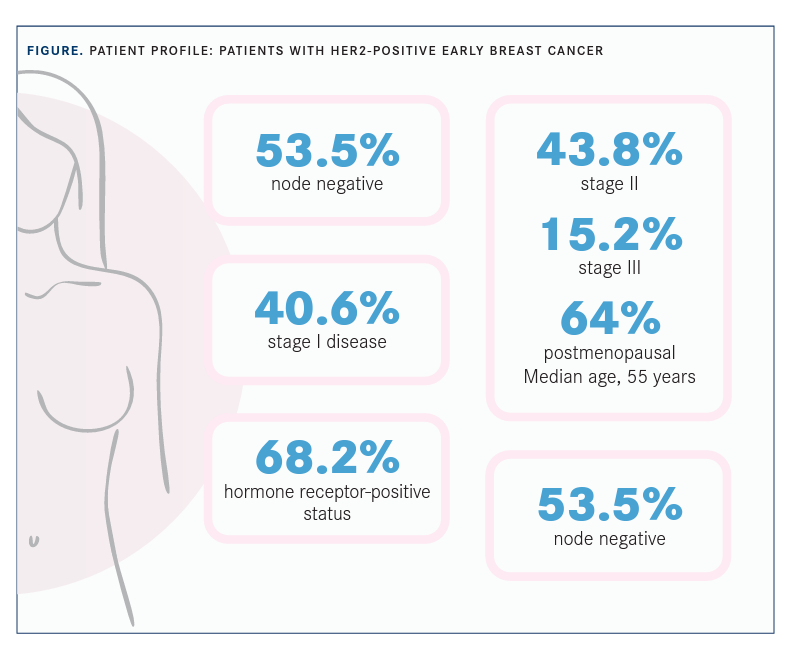Promising Long-Term Results for HER2+ Early Breast Cancer
Adjuvant trastuzumab is showing promising long-term results in patients with HER2-positive early breast cancer, a population that is representative of most patients seen in clinical practice.
Pier Franco Conte, MD

Adjuvant trastuzumab (Herceptin) is showing promising long-term results in patients with HER2-positive early breast cancer, a population that is representative of most patients seen in clinical practice.¹ These updated survival data from the phase 3 SHORT-HER trial (NCT00629278) were presented during the European Society for Medical Oncology Breast Cancer Virtual Congress 2021.
“Patients classified as low/intermediate risk based on [tumor] size and nodal status represent 84.6% of the SHORT-HER study population. Long-term disease-free survival [DFS] and overall survival [OS] are superimposable between the 2 treatment arms,” Pier Franco Conte, MD, said during the presentation. “Although 1 year of trastuzumab remains a standard, deescalation of treatment is a reasonable option for a large proportion of a real-world population of [patients with] HER2-positive early breast cancer.”
Conte is a professor of oncology at the University of Padova, director of the Division of Medical Oncology at the Istituto Oncologico Veneto in Padova, and chairman of Rete Oncologica Veneta in Italy.
After a median follow-up of 8.7 years, patients who received 1 year of trastuzumab had a 5-year DFS rate of 87.9% vs 85.8% for those who received it for 9 weeks (HR, 1.09; 90% CI, 0.88-1.35). Patients had a 5-year OS rate of 95.1% in both arms (HR, 1.18; 90% CI, 0.86-1.62).
The superiority of combining 1 year of trastuzumab with adjuvant chemotherapy versus chemotherapy alone in patients with HER2-positive early breast cancer was demonstrated in the phase 3 HERA trial (NCT00045032), the NSABP B-31/NCCTG N9831 joint analysis, and the N9831 trial(NCT00005970).2-4In November 2006, trastuzumab was approved by the FDA as an adjuvant therapy for patients with HER2-positive, node-positive breast cancer as part of a treatment regimen containing doxorubicin, cyclophosphamide, and paclitaxel.5
“It was very clear at the time that the choice of a 1-year duration of trastuzumab administration was based empirically and that a similar degree of benefit had already been reported with the small FinHER study with 9 weeks of trastuzumab,” Conte noted.
The SHORT-HER trial, an investigator-driven, non-inferiority study, started off with an initial sample size of 2500 patients; however, as of February 2011, it was amended to 1250 patients. The study was con-ducted across 82 investigational sites in Italy and had a recruitment period that ran from December 2007 to October 2013. The primary analysis was completed after 189 DFS events at 5.2 years of median follow-up.

The trial enrolled patients with HER2-positive, node-positive, or high-risk node-negative disease. Patients were then randomized to receive either 1 year of trastuzumab plus chemotherapy, which included 4 courses of doxorubicin and cyclophosphamide, followed by 4 courses of a taxane versus 3 courses of docetaxel combined with 9 weeks of weekly trastuzumab followed by 3 courses of fl uorouracil, epirubicin hydrochloride, and cyclophosphamide. Stratifi cation factors included hormone receptor status and nodal status. Patients 65 years or older received 80 mg of docetaxel. Eleven percent of patients who received the longer duration of trastuzumab were given paclitaxel at a dosage of 175 mg.
The overall patient population had a median age of 55 years (range, 25-78), and 64.0% were postmenopausal. Moreover, 40.6% of patients had stage I disease, 43.8% had stage II disease, and 15.2% had stage III disease. Most patients were node negative (53.5%), although 30.7% of patients had 1 to 3 positive nodes and 15.8% had at least 4 positive nodes. Additionally, 68.2% of patients had hormone receptor–positive status (FIGURE).
The DFS reported in the primary analysis of the trial showcased a HR of 1.13 (90%, CI, 0.89-1.42). Investigators reported that the probability of the shorter duration of treatment being noninferior to that of the longer duration was 78%.6 Moreover, the primary analysis identified an association between a longer duration of treatment and a longer and higher incidence of cardiac events. The incidence of grade 2 or higher cardiac events was 13.1% in the long-duration treatment arm versus 4.3% in the short-duration treatment arm.
The updated results of the study had a median follow-up of 8.7 years with 237 DFS events and 109 deaths. Investigators also examined DFS and OS outcomes with respect to risk category.
“The high-risk group clearly has worse outcomes in terms of both DFS and OS, while both low- and intermediate-risk groups had very good DFS and OS estimates,” Conte said.
Patients in the low-risk group experienced a 5-year DFS of 91% in both treatment arms (HR, 0.91). In the intermediate-risk group, those treated for the longer duration had a 5-year DFS rate of 88% vs 89% of those who received the shorter duration (HR, 0.88); the 5-year DFS rates in the high-risk group for the longer and shorter treatment durations were 82% and 64%, respectively (HR, 2.06).
Additionally, the 5-year OS rate for patients in the low-risk group who received the longer duration of treatment was 97% vs 99% for patients who received the shorter duration (HR, 0.57). In the intermediate-risk group, these rates were 96% and 95%, respectively (HR, 1.14), and they were 95% and 91%, respectively, in the high-risk group (HR, 1.09).
REFERENCES
1. Conte P, Frassoldati A, Bisagni G, et al. Nine weeks vs 1 year adjuvant trastuzumab: long term outcomes of the Short-HER randomized trial. Presented at: European Society for Medical Oncology Breast Cancer Congress 2021; May 5-8, 2021; virtual.
2. Herceptin (Trastuzumab) in treating women with human epidermal growth factor receptor (HER) 2-positive primary breast cancer (HERA). ClinicalTrials.gov. Updated April 27, 2017. Accessed May 7, 2021. https://clinicaltrials.gov/ct2/show/NCT00045032
3. Doxorubicin and cyclophosphamide plus paclitaxel with or without trastuzumab in treating women with node-positive breast cancer that overexpresses HER2. ClinicalTrials.gov. Updated April 29, 2021. Accessed May 7, 2021. https://clinicaltrials.gov/ct2/show/NCT00004067
4. Doxorubicin hydrochloride, cyclophosphamide, and paclitaxel with or without trastuzumab in treating women with HER2-positive node-positive or high-risk node-negative breast cancer. ClinicalTrials.gov. Updated August 14, 2020. Accessed May 7, 2021. https://clinicaltrials.gov/ct2/ show/NCT00005970
5. FDA approves Herceptin for the adjuvant treatment of HER2-positive node-positive breast cancer. News release. Genentech Inc. November 16, 2006. Accessed May 7, 2021. https://bit.ly/3vNSNpX
6. Conte P, Bisagni G, Frassoldati A, et al. Final analysis of the phase III multicentric Italian study Short-HER: 9 weeks vs 1 year adjuvant trastuzumab for HER21 early breast cancer. Ann Oncol. 2017;28(suppl 6):vi1vi2. doi: 10.1093/annonc/mdy414

FDA Grants Clearance for Phase 1 Trial of BL-M17D1 in Solid Tumors
November 11th 2024Following the clearance of an investigational new drug application from the FDA, a phase 1 trial will examine the novel antibody-drug conjugate BL-M17D1 in patients with advanced or metastatic solid tumors.
Read More